Nokia N8 Review: Nokia's New Flagship
by Mithun Chandrasekhar on January 12, 2011 1:00 AM EST- Posted in
- Smartphones
- Nokia
- N8
- Symbian
- Mobile
HTPC in your pocket?
So while the GPU in the N8 is competent, the display it drives is quite up to the task itself. Nokia is making use of a 3.5” AMOLED panel, running a resolution of 640x360 pixels. While certainly not the highest in terms of pixel density, it is vibrant and crisp with good contrast. The AMOLED panel on the N8 is very good and surprisingly, it actually uses a regular RGB sub-pixel grid, unlike the Pentile configuration found in most other AMOLED displays. This makes the display, in general, sharper than other AMOLED’s, especially when viewing text.
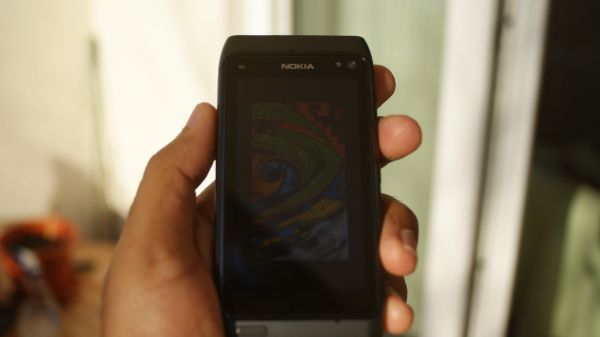
N8’s visibility outside is decent (left), but nothing great.
It has very good visibility indoors and decent visibility outdoors—especially for being an AMOLED display—but still isn’t quite as good as some regular LCD displays. Even though the N8 is Nokia’s current flagship device, it doesn’t have the outdoor-visibility enhancing ‘Clear Black Display’ technology (aka polarizing filter). The ambient light sensor does its job very well and adjusts the brightness within a second or two of change in the lighting conditions. It also does a good job of maxing-out the brightness when outdoors under sunlight, although it doesn’t seem to want to dip to the other end when in complete darkness.
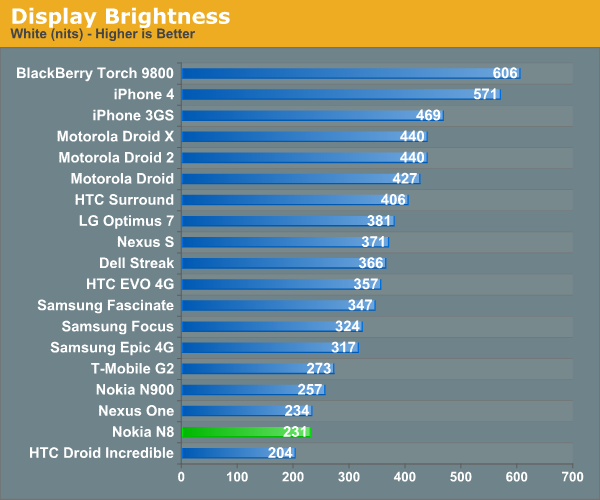
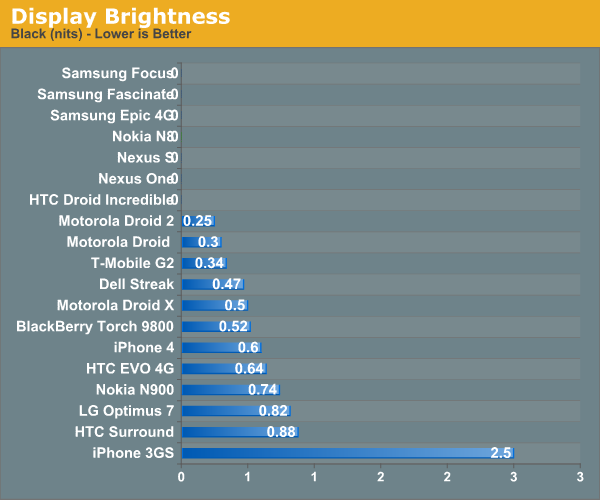
The N8 excels as a camera and as a phone. But another area where it does quite well for itself is multimedia. There is another first for the N8; it is the first mobile device to sport a complete implementation of the Dolby Digital Plus standard. What this means is that the N8 is capable of streaming out 5.1 audio without any issues.
Video playback on the Nokia N8
The N8 also houses a v1.3a-spec mini HDMI connector (Dolby Digital Plus needs at least a v1.3 connection) up top that works just as it should. Connect the N8 to your TV using the included cable and you’re all set. And Nokia has paid a lot of attention to its implementation of HDMI-out on the N8. Instead of simply mirroring or cloning the N8’s display over the HDMI connection as most phones do, Nokia has implemented what it calls a “native” mode, wherein during media playback, the on-screen controls are the only thing that is displayed on the N8. The actual image/video stream is only visible on the HDTV and it is unobstructed by the playback controls. While it doesn’t really change how you would watch videos or images per se, it just goes to show the level of detail Nokia has gone into while implementing seemingly inconspicuous features.
The N8 also supports Matroska and DiVX playback out-of-the box without having to download, install or configure anything. I threw a couple of 720p DiVX trailers at it and it played them without issues. I did have some trouble with a couple of MKV’s encoded using “high-profile” (even though the specs say it supports it), and a few high-bit rate videos (I think around 10Mbit/sec is the usable limit) where I would only get the audio stream playing, as the N8 could not identify the video stream. But it was awesome to just drop stuff off onto the N8 and watch it go. If I found one issue with the video player on the N8, it has to be its inability to resume playback from where it left off; whether this means you explicitly press pause and close the video player or just directly switch over to another app, the N8 starts playing back the video from the very start every time.

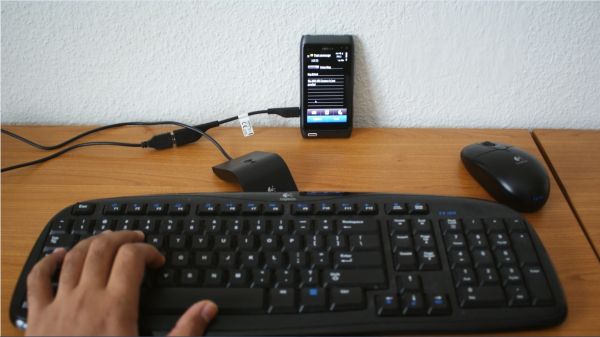
The N8’s excellent media handling coupled with USB OTG make it a great basic ‘HTPC’
And speaking of go, the N8 is one of the few devices that supports the USB OTG (On-the-Go) standard which allows it to act as a USB host for certain devices. Once again, this works flawlessly. I copied a couple of ripped videos onto a USB drive, plugged it into the N8 (via the supplied USB to micro-USB dongle) and the N8 immediately picks up the drive as a mass-storage device and lets me browse its contents. Again, no need to install or configure anything. The only restriction here is that the drives must be FAT32 formatted, not NTFS. The N8 is capable of providing up to 200mA over its micro-USB port, but I could use externally powered devices (such as my 1TB external drive) without any issues. I tried using a bunch of devices such as USB flash drives, digital cameras and they all seem to work fine. But I had two portable drives that understandably didn’t work with the N8 because of power requirements; I could just hear them power up and down continuously.
Just out of curiosity, I tried connecting a Logitech EX100 wireless Keyboard+Mouse combo and it worked! I could use the mouse to navigate and interact with the menus without any fuss and in seconds I was typing out emails on the N8 through the keyboard. This really does make it a viable HTPC option. Nokia has also thrown in an FM radio (with the wired headset acting as an antenna) and the N8 can also act as an FM transmitter. While not entirely useful in this day and age where almost every vehicle comes with at least an AUX IN jack, it certainly is a nifty feature for those who don’t have any other means of streaming audio through their vehicles speaker setup. In my brief use of the N8 as an FM transmitter, it did quite well even in areas with multiple transmitting stations.
And Nokia has another bit of surprise here. The N8 comes with 16GB memory built-in that can be expanded using microSD cards, currently giving you a maximum storage capacity of 48GB. While a lot of phones currently available come with large amounts of storage memory, in my experience, I rarely ever end up using more than a couple of gigabytes simply because of the painfully slow transfer speeds. Not so with the N8. I have recorded sustained read speeds of 13MB/sec and write speeds of about 10MB/sec. This means I can transfer a 700MB video in a little over a minute. Have a look the numbers below for comparison.
| Device | Read (MB/s) | Write (MB/s) |
| Nokia N8-00 16GB | ~13 MB/s | ~10 MB/s |
| Palm Pre Plus 16GB | ~15 MB/s | 1.5 MB/s |
| ADATA C802 4GB | ~13 MB/s | ~4 MB/s |
I couldn’t get more specific information on the Toshiba THGBM1G7D4FBA13 MCP used part used in the Nokia N8, but it contains four 32Gbit Toshiba-Sandisk MLC NAND die along with a flash controller.










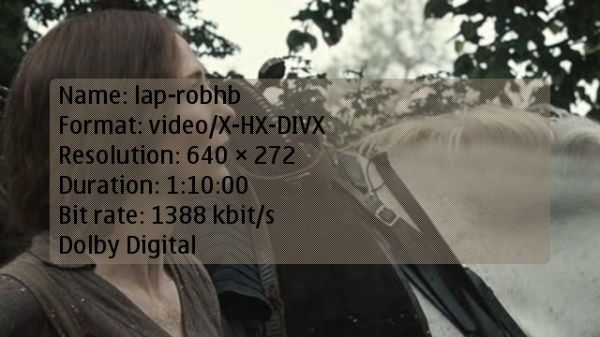
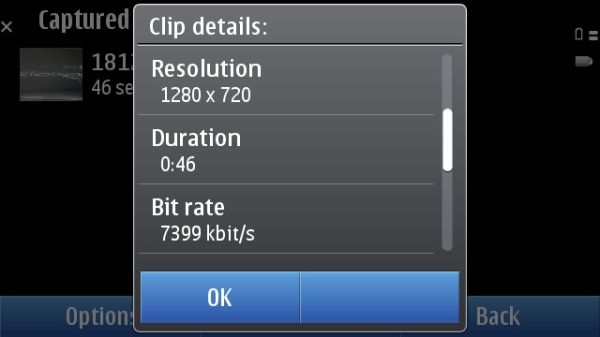
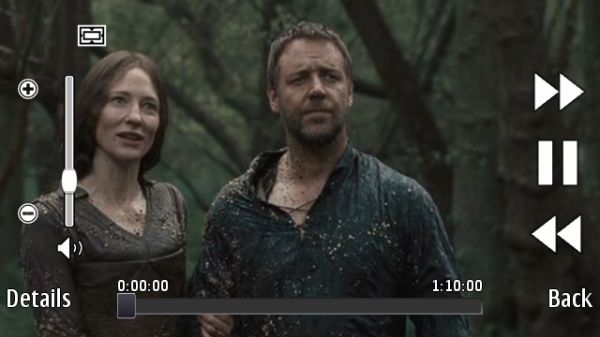








119 Comments
View All Comments
cheezyuser - Wednesday, January 12, 2011 - link
I'm not trying to sound fanboism, but thats my point exactly, People are just harping on Android, iPhone, apps, and when it comes to Nokia, they are quick to point out the flaws, which in my point, there isnt much (except for thoes synthetic benchmarks). Anandtech is mostly right in what they say, and it gets the job done,Just because my phone has the highest battery life doesnt mean im not gonna charge it for long days, nor does it display web pages faster mean i can tweet faster then my friends.
this android/iPhong hype is going over the top
inaphasia - Wednesday, January 12, 2011 - link
"...the 5110i served me very well for more than 3 years without showing any signs of aging. That was in the mid to late 90’s"Not that it matters but that phone probably came out around 98-99. I remember 'cause '99 was the year I got my first mobile. A Motorola that would take 4xAA alkalines if you wanted! I loved the 5110 but by the time my Motorola died I ended up with my favorite phone ever, a Nokia 6210. Had it for a little over 4yrs! No really!
jonup - Thursday, January 13, 2011 - link
Second on the 5110, which I had. And while not much different I was always a big fan of 6310i but the 6210 would do as one of the greatest ever. But for the pure market share 5110 was the king. Just about every one had one.santu - Thursday, January 13, 2011 - link
I was hoping that Anadtech review talks about signal loss problem when touching the phone. I have gone through three phones and all have antenna problem. Even in the user manual, Nokia recommends the user not to touch the phone in certain places.Luke.mc - Thursday, January 13, 2011 - link
Mithun, one of the gripes with the phone seemed to be the poor browser, but you also said Opera Mobile was an excellent experience. Could you post your tests using Opera Mobile on multiple phones as to give a more accurate hardware picture?mythun.chandra - Friday, January 14, 2011 - link
I'd like to do so. But as of now, I do not have enough devices on hand to put reference numbers. Plus, even out of the few devices I do have, only the Nokia's have Opera Mobile available. But I will make it a point to include reference Opera Mobile wherever possible :).mcquade181@gmail.com - Friday, January 14, 2011 - link
I've had my N8 for 6 weeks now. It replaced a 2 year old Nokia N95. I'm reasonably happy with it although for phone calls my N95 was better.I had previously borrowed a couple of Android phones (both v2.1) to try out and found then bug ridden heaps of 2nd rate hardware (both were HTC's).
I've found the N8 to be quite a bit better than them, however all is not roses with the N8 as I have issues with the N8's front and rear speaker/ringer design and volume.
If you put the N8 on a soft flat surface or carry it in a leather belt pouch the ringer is completely inaudible! The engineers who designed the rear speaker must been straight out of Uni without any design experience! The speakers should have been twin side mounted speakers aka N95.
Another issue that I have is with lack of earphone speaker volume - in a noisy environment the phone is useless - hopefully this will be addresses in a firmware update.
I'm not the only one complaining about these two issues - do a google search for "N8 volume".
noxplague - Saturday, January 15, 2011 - link
I have had the N8 for three weeks now and, while everyone on here who has never used one is all worried about the specs and the tests these, volume issues are far more relevant in day to day use.One thing that frustrates me to no end is the fact that on the home screen using the volume rocker does nothing! To me this should be the quick way to change my ringer volume. Instead you are supposed to use these "profiles", but having a profile with the right volume for each scenario is time consuming when I just want to turn the volume up or down but leave the rest of the settings (there are loads) alone.
The phones that I switch between lately are a WP7 Samsung Focus, a Palm Pre Plus (need to pick up the 2...), and the Nokia N8. The email/exchange experience on the N8 is my main problem. It lags so far behind the competition to be considered barely usable. The fact that you cannot easily contact meeting attendees from the calendar is a huge oversight compared to the WebOS, WP7 OSs. When you move between meetings all day and are running late it is nice to be able to let people know quickly.
My last comment is on Opera Mobile 10.1 - Everyone talks about how great it is but for me it crashes a far amount and doesn't support pinch zoom! This is annoying whenever you are on a full website. I often switch between Opera and Web, but even slow I find Web better just because it doesn't crash and I can zoom around a website.
Fix the exchange experience, the volume experience, and the web and this phone would be a top contender.
The hardware is stunning, preferable to either the palm, focus and camera is worth it alone.
munky - Friday, January 14, 2011 - link
All you people whining about ARM11, MHz, and so-called "standards" have obviously never used the N8. Kinda reminds me of all the armchair photographers who argue about camera specs without ever using it. As a photo enthusiast, the camera alone makes this phone worth considering, and instantly makes all the other phone cameras look like stone age tech.It has 3G on all 5 bands, meaning I can get T-Mobile 3G for $6/month, no contract, as opposed to all your mandatory 2-year contracts with $30/month data plans elsewhere.
The AMOLED screen has great colors and visibility in any lighting condition, something Apple still hasn't "invented."
The multi-tasking capabilities are second to none - try following turn-by-turn navigation while listening to music while taking pictures all at the same time on your phone, and tell me how it goes.
The reception on this phone is even better than previous Nokia's I've owned. The company with a fruit logo is not even playing in the same ballpark.
The web browsing is smooth also, and I can view flash content directly in the browser - I don't need no stinking "app for that."
Now, if all you do is browse the web and download games for your phone, then you don't need the N8. Hell, you don't need a phone at all - get an Ipod Touch and go brag to your neighbors. But if you want a multimedia device with some real capabilities, then don't bash the N8 until you've actually used it.
pandemonium - Saturday, January 15, 2011 - link
Well said, munky.For everyone else needing another perspective on the N8's abilities, you need to read these two articles on gsmarena.com: http://www.gsmarena.com/nokia_n8-review-523.php; http://www.gsmarena.com/display_shootout-review-54...
That site has several well thought out and fair comparisons and reviews of several brands and models.
My personal experiences with Nokia devices in general have taught me that battery life is amazing, hardware quality is the best, Symbian OS is sometimes twitchy but very efficient and adaptable, call and reception quality are better than most, and value is very high compared to cost [against other brands]. You can compare listed specs all day long, but when it comes down to it the function of the OS against the capabilities of the hardware and the utilization and limits of software combined is what makes a great phone great. It's the same as HDTVs; so what if yours has 5,000,000 : 1 contrast ratio? Those numbers are inflated and only relevant within that brand and that brand alone and say nothing about color accuracy, black levels, viewing angle, subfield motion correction, etcetera, etcetera.